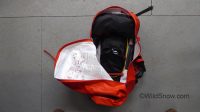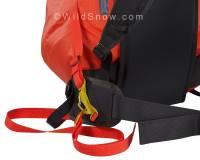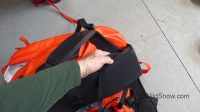The battle of the fan packs is engaged. While compressed gas avalanche airbag backpacks are the clear winners of the weight war, electric packs have advantages. Mainly, easy to practice triggering, and easy to travel with. I love the concept and I’ve had a load of fun working with both brands these past few years. Amazing what human ingenuity can accomplish — kudos to both companies!
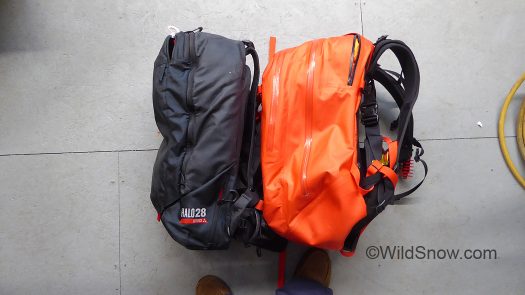
Halo 28 Jetforce, left, and Voltair 30. Voltair has more cargo capacity but Halo is larger than you’d think due to it being slightly taller and having a large skin and tool compartment that’s fully layered over the main compartment. Both packs held my day touring gear: Halo packed tightly, Voltair somewhat roomy for my normal load.
Covered here: the Arcteryx Voltair 30 and Black Diamond Halo 28 Jetforce. Rather than developing carpel tunnel from keyboarding full names, we’ll mostly call them the Voltair and Jetforce (or Halo 28). Please know I chose these two rucks for the comparo because in my opinion they’re closest to the size “day tour” ski pack I’d carry, despite the moderate difference in volume. To put it in practical terms, depending on exact pack contents I find the Halo to sometimes be a little small, while the Voltair is usually too large.
Weight and cargo space
If you’re hoping or perhaps even praying that one of these companies made weight saving battery or textile breakthroughs, sorry to disappoint. Both these rucks thrash your shoulders with upwards of 3 vertebral crushing kilos. Jetforce masses at 3484 grams on our scale, Voltair at 3520. Compare to an available state-of-art 30 liter gas airbag pack at 2.6 kilos.
Thus, this is simply a straight battle on features. I experimented and could fit somewhat more junk in the Voltair as opposed to the Halo 28. But again, not to the point where I’d put the two packs in different classes in terms of volume. Important: if you mess around with fitting your kit to the Halo 28 be sure to consider its rather large skin and tool pocket, which compensates significantly for the small “main” compartment.
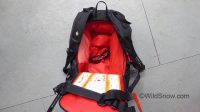
Main compartment of the Jetforce is filled with airbag componentry, balloon to left and top, with fan system to right. This prioritizes the clamshell tool-skin compartment, which fortunately is quite large.
Again, both packs have plenty of room for the average day touring kit — which is why I’m pitting them against each other. But add “guide” type gear such as bivy sacks and larger emergency kits and you need to experiment with real-life loading. That’s where your brick-and-mortar shop comes into play.
On the other hand, if you reach certainty in your shopping nirvana by virtue of this 2,000+ word review (I’m channeling Kerouac’s booze fueled typewriter stream of consciousness scroll writing, apologies), we always appreciate your supporting our work by shopping our links.
Airbag technology
The first thing many consumers notice when they’re studying the specifications is that Voltair has a 150 liter airbag, while Jetforce is 200. That’s a startling difference that results in the Jetforce stowing significantly more fabric mass and volume. Some shoppers might simply buy the higher number — perhaps the same people who buy DIN 16 instead of DIN 10 bindings because of the bigger digits. Stop. My understanding is that decades of testing have shown that a 150 liter airbag does the job in most situations. So why the larger Jetforce balloon? My first guess would be it’s mostly a marketing factor, but I’d also guess that if you’re quite a large person, carrying a heavy pack, more volume makes sense.
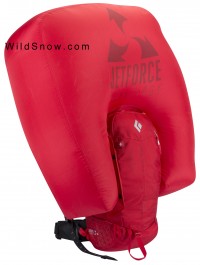
The 200 liter Jetforce balloon is huge. Nice when you want it to buoy you out of a slide, but the additional fabric clearly adds weight and takes up space in the pack.
BD official take? They told me that their ducted fan and battery system is so robust it can easily push the bigger balloon, and they felt that indeed in the case of a larger skier with a heavy pack, 200 liters could be beneficial. Further, BD has told me many times that their design philosophy with Jetforce is to “leave no stone unturned” in making the pack as reliable and safe as possible; that those factors supersede weight and price point (though Jetforce comes at a lower MSRP than Voltair, it’s still significantly more costly than most if not all current gas packs).
In my opinion BD’s design philosophy (safety first!) is indeed valid. Yet, I’d be an idiot if I didn’t question how a pack with 8 or 9 compartments (not counting tool slots) and numerous zippers is any safer than a lighter simpler sack with one zipper and one compartment.
Regarding both Jetforce and Voltair, my understanding (correct me if I’m wrong) is that European standards for airbag backpacks require them to inflate at least once at negative 30 degrees centigrade (-22 F). In other words 999 out of 1000 ski tourers are being asked to lug around a gigantic battery just so 1 out of 1000 will be sure a hopped up cordless vacuum cleaner will work when it’s 22 degrees below zero Fahrenheit. At those temperatures, keeping your headlamp functional and your feet safe from amputation are often of more immediacy than keeping a battery operated pack in working condition. Besides, throw a chemical hand warmer in next to the battery and pack a puffy in there (you’re tough, so you’re not wearing it, yet) and that battery is going to take a long time to cold soak if you began your day at room temperature.
Thus, I can offer a firm take: for most of you, the bigger balloon of the Jetforce or the welding capable battery of the Voltair are NOT deal makers or breakers, but for some of you they could be. It is not a cliche to say “you know who you are.”
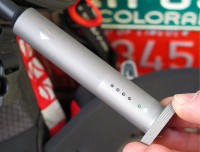
Jetforce trigger handle has LEDs indicating various things. Mainly, the number of lights above (left) of power light indicate
the state of the battery.
The two packs trigger in somewhat different ways. Voltair is entirely mechanical, with a cable that pulls a latch open at the top airbag compartment along with activating the electric motor control. Jetforce has electronics built into the trigger handle; tiny lights that indicate what state the system is in. The Jetforce lights do not indicate an exact percentage of charge — they give you a rough yet adequate idea.
Voltair has a basic two-light indicator that’s located on the pack next to your left shoulder, only green or red. This is difficult to check with the pack on, so a small mirror is attached with a string to the hip belt, you use to check the lights, ostensibly required by European regulations and nearly as ridiculous as Hillary and Donald shaking hands. For your first mod on $1,000 equipment remove the mirror (you are now an official Wildsnow modder!), or keep it for eyeliner checks.
In the case of either pack, all you really need is something that tells you the battery has enough juice for one blowup and-or fully charged. Both systems provide this.
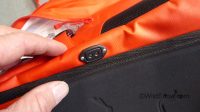
Voltair has lights as well, simple. Green and it’s ready, red and it’s not. It’s perhaps an issue that these are difficult to see when you’re wearing the pack. To remedy that, powers that be are requiring Arcteryx to sell the pack with a mirror affixed to the shoulder strap. We of course recommend removing this immediately upon purchase — unless you need it for checking your eyeliner.
So, what about those batteries? Voltair uses a lithium polymer (Lipo) that can be made into any shape but is quite sensitive to cold. Jetforce uses lithium ion that is manufactured in various sized cells, the shape of which can be seen in the Jetforce battery case. I’m told the lithium ion while still sensitive to cold, is less so, and the Jetforce battery can thus be smaller and lighter. Both battery systems are big, kludgy and heavy — but the Jetforce is somewhat smaller. Too bad the Halo pack itself is so heavy, as it appears BD could have beat Arcteryx in the weight department by using a cleaner and simpler pack design.
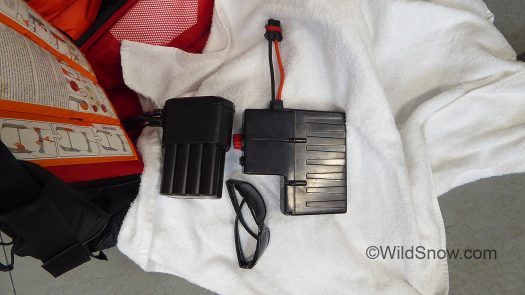
Batteries, Jetforce to left, Voltair on right. This is not a totally fair apples-apples comparison as the packs package various amounts of their electronics with the battery as well as in separate locations. But the Voltair battery is indeed large.
When you pull the Jetforce trigger, you pull a rod on the side of the pack that’s threaded through a closure system, thus opening up the airbag compartment. Similar in concept to Voltair (which has a small, cable actuated clasp) only more complex. Presumably, this is necessary because of the larger airbag needing more storage space than only using the top portion of the pack, as Voltair does. Both trigger systems are ingenious, while their complexity leads me to believe there may be room for simplification and weight reduction.
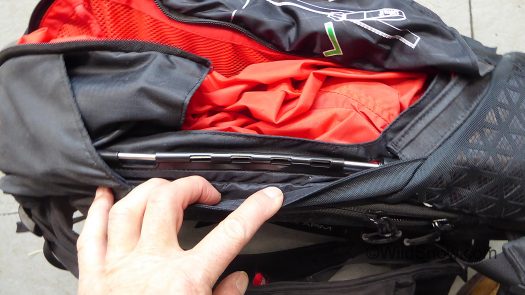
Jetforce threaded rod closure system. Once you practice with either pack, re-stowing the airbag is not a big deal.
Features
The first thing I noticed about Jetforce is the extraordinary and often a bit over the top effort the designers made to create a “clean” backpack that is so free of exterior straps and other gewgaws you wonder if it’s really a ski touring rucksack and not airport luggage. More, the number of compartments, zippered or otherwise, will probably keep gear geeks happy for hours. I tried to count the slots and pockets; around 8 or 9 not counting the tool holders and airbag component storage. Voltair is not as clean on the outside, it boasts obvious climbing tool storage and compression straps. These are nearly all removable if you do want that luggage look.
Voltair has no extra pockets or compartments (other than tool-skins partition), and only one extra zippered slot for access to the battery power switch (again, not counting tool partition). Design philosophy here is clearly different than that of BD. You won’t find storage for the trigger handle (instead it firmly switches to a disarmed position). Helmet carrier would have to be added. Leg strap has no stowage (we think that’s best, as using an airbag pack without leg strap is an invitation to strangulation). In my view, Arcteryx might have gone too far with simplification. I do like having a small accessory pouch on my waistbelt. Halo has it, while Voltair has a tiny open topped pouch that doesn’t count (though it would stow your chapstick).
One of my pet peeves is how the leg strap is attached. I don’t like threading it into the waist belt (Jetforce), necessitating a fiddly glove unfriendly process when you put your pack on or take it off. A specially designed system for clipping the strap to the pack (Voltair) is better. You can jury rig this with a carabiner, but when used that way a ‘biner can open accidentally. I expect most airbag backpack makers will eventually provide clip systems similar to Arcteryx.
It’s worth mentioning that Jetforce has a shoulder strap system BD calls Reactive Suspension, consisting of a steel cable anchoring the bottom ends of the shoulder straps. The cable slides behind your back, allowing the straps to change length by a few inches. In my view this is a solution without a problem, only adding cost and weight.
To be fair, I find the Arcteryx suspension a bit odd as well. The Voltair waist belt is presumably rigged to float behind the lumbar pad (again, overly complex in my opinion), and it uses a plastic buckle instead of the obviously beefy aluminum “keylock” buckles used by most other airbag backpacks. I’d imagine the Arcteryx buckle is tested and approved. While it’s easier to use than the keylock type, it does not inspire confidence in this key component of an airbag backpack. Overall, the suspension on both packs worked during my testing, yet both beg for simplicity.
Voltair is nearly a drybag what with taped seams, water resistant zippers and fabric worthy of a Grand Canyon raft repair kit. But this adds weight, and personally I don’t need it. Jetforce, while still rather massive, obviously doesn’t have the water phobia of the Voltair — though for most of us it would be fine.
There are those of you whose first and last question is “helmet carrier?” Jetforce Halo 28 has it, Voltair 30 does not. The Halo carrier is sewed on but can easily be razored off. An aftermarket net can be added to the Voltair. Or just wear your helmet?
And, there are those of you who will ask about ski carrying features. Both packs can be rigged for diagonal ski carry, while A-framing is not facilitated and not recommended due to obstruction of the balloon. Black Diamond provides a lashing system that’s obviously dedicated directly to skis. Arcteryx requires a bit of configuration.
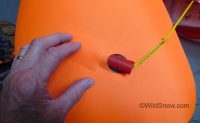
Voltair deflation straw is a simple plastic tube you insert into a flap valve on the inflated airbag balloon. Jetforce can be manually deflated as well, by moving a flapper valve door in the ducted fan housing inside the pack.
Fancy Dancy
Both systems do multiple blows after you trigger, to compensate for torn fabric. I’m not seeing any difference I’d call significant. Jetforce clearly wins the geek-out award for its automatic hoover vac deflation cycle (occurs 3 minutes after you trigger). You might think this is a battery depleting gimmick, but it’s actually quite nice (and could be a safety feature, see below). On the other hand, Voltair’s incredibly high tech deflation straw is incredibly low tech, and I like that. While fiddly at first, once you’re used to the Voltair process it’s brainless.
If you actually did get buried in the white tomb with your Jetforce, the automatic deflation cycle might create an air pocket. I like that concept but again I don’t think it’s a deal maker or breaker. It’s just a theory and somewhat reminiscent of current ski helmet mythology.
Jetforce has the full “force” of the Pieps electronics brain trust behind it, resulting in the fancy trigger handle with it’s lights and so forth. But is that a deal breaker one way or the other? I’d say no. This is basic. If you’ve got something you can pull on and blow the thing up, you’re good. All other fu fu is perhaps exactly that.
Conclusions
Sorry to waffle, but picking between these two warriors involves more than just who has the biggest biceps. If you are a large North American corn fed bruiser, the bigger balloon of the Jetforce is attractive. If you ski in wet weather, the obviously better water sealed Voltair rucksack is a winner.
Do you like simplicity? Voltair’s reliance on manual deflation and their simple handle pull are attractive. On the other hand, I do like the Jetforce “hoover vac” deflation. Very convenient, especially in situations such as heli skiing where your guides will cut you off from apres whisky should you be fiddling around with repacking a “premature deployment,” as well as making you the butt of jokes based on that phrase.
Honestly, despite listening to literally dozens of hours of lecturing from both companies, I don’t see any real difference between the batteries. Though it would be remiss of me not to mention the Arcteryx has a standardized battery connector that begs for an aftermarket weight saving solution (for those of us who stay home drinking tea when it’s twenty degrees below zero). Black Diamond obviously doesn’t want you fooling around with their closed electrical system, though I’m guessing they might someday supply a lighter weight battery as an option.
Voltair costs a few hundred dollars more. But then what happens when these things are on sale? Me, if someone said I had to carry one or the other on pain of death (realistic), I’d just flip a coin. Perhaps you should too.
Specifications
Balloon volumes: Voltair 150 liters, Jetforce 200 liters.
Cargo volume: Voltair is a few liters larger. If you pack quite a bit of kit this could be a factor. Next size up in BD Jetforce is the huge Saga 40. PIEPS Tour Pro 34 is also a Jetforce offering and could be closer to the optimal day-tour volume for most ski tourers.
Balloon fills per battery charge, room temperature: Voltair 12+, Jetforce 8+ (Estimated by me based on testing and information from makers, bear in mind that Jetforce uses electricity for deflation as part of overall blower cycle. Both packs have entirely adequate battery power, so quibbling about this is pointless.)
Weights: Halo 28 Jetforce 3484 grams, Voltair 30 is 3520.
Links
Our Jetforce coverage.
Our Voltair coverage.
All our airbag backpack coverage.
Voltair Manual as PDF
Jetforce Manual as PDF
Shop for Voltair and Jetforce.
WildSnow.com publisher emeritus and founder Lou (Louis Dawson) has a 50+ years career in climbing, backcountry skiing and ski mountaineering. He was the first person in history to ski down all 54 Colorado 14,000-foot peaks, has authored numerous books about about backcountry skiing, and has skied from the summit of Denali in Alaska, North America’s highest mountain.

